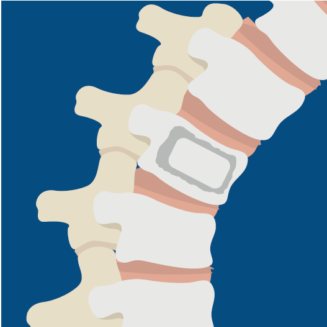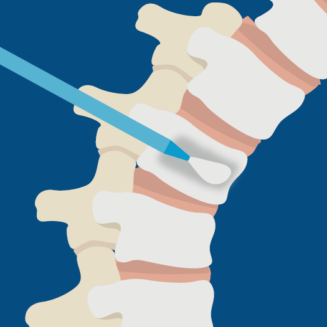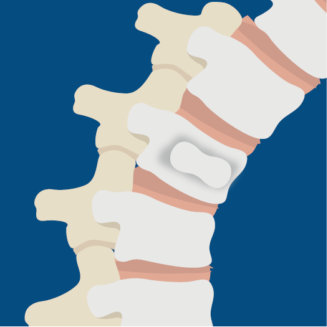VCF THERAPY
Take the assessment
Evaluate your patient suffering from Vertebral Compression Fracture pain and identify which is the most suitable treatment option

TREATMENT OPTIONS
NSM | VP | BKP | |
|---|---|---|---|
PRINCIPLE | Bed rest, bracing, physiotherapy, medication | Bone cement is injected into the vertebra to stabilize | Use of a balloon in the vertebra to restore kyphotic angle and then cement injection |
PAIN RELIEF | Over time Some | Immediate Most (1 year) | Immediate Most (2 year) |
SPINAL STABILIZATION | Not Satisfactory | Yes | Yes |
CORRECTS KYPHOSIS | No | No | Yes |
NON-SURGICAL MANAGEMENT
Treatment for back pain often include
BED REST
SPECIAL EXERCISE
BACK BRACING
PAIN MEDICATION
If your back pain is from a vertebral compression fracture, these non-surgical treatments will not correct the fracture or restore the height of your vertebra (the bones that make up the spine). Non-surgical management has been shown in clinical studies to have limited effectiveness in reducing pain and improving function long term compared to interventional treatment, thus treatment options like balloon kyphoplasty should be considered. [2 - 6]
VERTEBROPLASTY
PROCEDURE

In a vertebroplasty, the surgeon uses a small gauge osteo introducer to percutaneously access the vertebral body and inject highly viscous bone cement into the trabeculae to stabilize the fracture.
GOAL

This minimally invasive treatment is designed to relieve pain and stabilize vertebral compression fractures.
BALLOON KYPHOPLASTY
- Osteoporotic VCFs in any area of the spine that have been present for more than two weeks, causing moderate to severe pain and unresponsive to conservative therapy [10]
- Painful metastases and multiple myelomas [10]
- Painful vertebral hemangiomas (benign, malformed vascular tumors composed of newly formed blood vessels) [10]
- Vertebral osteonecrosis (a condition resulting from poor blood supply to an area of bone, which causes bone death) [10]
- Reinforcement of a pathologically weak vertebral body before a surgical stabilization procedure [10]
Complication rates for vertebroplasty and kyphoplasty have been estimated at less than 2% for osteoporotic VCFs and up to 10% for malignant tumor-related VCFs. The benefits of surgery should always be weighed carefully against its risks. Although a large percentage of patients report significant pain relief after these procedures, there is no guarantee that surgery will help every individual. [10]
MEDTRONIC BKP
Kyphoplasty may be recommended when one or more VCFs have caused the kyphosis. The procedure should be completed within 8 weeks of when the fracture occurs for the highest probability of restoring height.
BALOON KYPHOPLASTY
THE POWER OF
THE BALOON
Watch what happens during the procedure
KEY FEATURES OF THE KYPHON™ BALLOON KYPHOPLASTY PLATFORM
- 700 psi max rated inflation pressure, higher than previous 400 psi rated balloons [•]
- Cement resistance technique lets you deliver cement through one cannula while the contralateral balloon remains inflated to maintain fracture reduction
- Kyphon™ cement delivery system (CDS) lets you deliver cement from up to 48 inches away from the radiation source during a kyphoplasty procedure
BRIEF STATEMENT
See the device manual for detailed information regarding the instructions for use, indications, contraindications, warnings, precautions, and potential adverse events. For further information, contact your local Medtronic representative and/or consult the Medtronic website at medtronic.eu.
REFERENCES
- Kyphon Express™ II and Kyphon Xpander™ II ITBs have a maximum pressure rating of 700 psi while Kyphon Express™ II and Kyphon Xpander™ first generation ITBs have a maximum pressure rating of 400 psi.
- Rao RD, Singrakhia MD. Painful osteoporotic vertebral fracture. Pathogenesis, evaluation, and roles of vertebroplasty and kyphoplasty in its management. J Bone Joint Surg Am 2003;85-A(10):2010-22
- Berenson J, Pflugmacher R, Jarzem P, et al. Balloon kyphoplasty versus non-surgical fracture management for treatment of painful vertebral body compression fractures in patients with cancer: a multicentre, randomised controlled trial. Lancet Oncol. 2011;12(3):225-235.
- Wardlaw D, Cummings SR, Van Meirhaeghe J, et al. Efficacy and safety of balloon kyphoplasty compared with non-surgical care for vertebral compression fracture (FREE): a randomised controlled trial. Lancet. 2009;373(9668):1016-1024.
- Boonen S, Van Meirhaeghe J, Bastian L, et al. Balloon kyphoplasty for the treatment of acute vertebral compression fractures: 2-year results from a randomized trial. J Bone Miner Res. 2011;26(7):1627 1637.
- Van Meirhaeghe J, Bastian L, Boonen S, et al. A randomized trial of balloon kyphoplasty and nonsurgical management for treating acute vertebral compression fractures: vertebral body kyphosis correction and surgical parameters. Spine. 2013 38(12),971-983.
- Klazen C, Lohle P, de Vries J, et al. Vertebroplasty versus conservative treatment in acute osteoporotic vertebral compression fractures (Vertos II): an open-label randomised trial. Lancet. 2010;376(9746):1085-1092.
- Jay Jagannathan, MD, FAANS. Vertebroplasty After a Painful Spine Fracture. https://www.spine-health.com/treatment/back-surgery/vertebroplasty-after-apainful-spine-fracture
- International Osteoporosis Foundation Website. https://www.iofbonehealth.org/breaking-spine-report-2010. Accessed December 2018
- Wardlaw et al. Balloon kyphoplasty in patients with osteoporotic vertebral compression fractures. Expert Rev. Med. Devices 9(4), 423–436 (2012)
- Louis George Jenis, MD, FAAOS. American Academy of Orthopedic Surgeons. OrthoInfo. (2019). Osteoporosis and Spinal Fractures.
* The Assessment tool is based on the following publications:
- Anselmetti GC, et al. Criteria for the appropriate treatment of osteoporotic vertebral compression fractures, Pain Physician 2013; 16: E519-E530
- Schupfner R, et al. Treatment of osteoporotic vertebral compression fractures: Applicability of appropriateness criteria in clinical practice. Pain Physician 2016; 19: E113-E120


